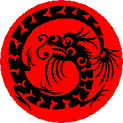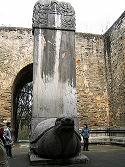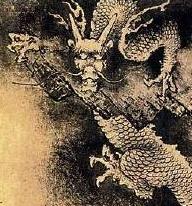
The first day of the 2012 Chinese New Year is on January 23, 2012 in China's time zone. This day is a new moon day, and is the first day of the first Chinese lunar month in the Chinese Lunar Calendar system. The exact new moon time is at 15:40 on 23-Jan-12 in China's time zone.
The Year 2012 is the 4709th Chinese year. The Chinese believe that the first king of China was the Yellow King (he was not the first emperor of China). The Yellow King became king in 2697 B.C., therefore China will enter the 4709th year on January 23, 2012. Also, the Chinese Year uses the cycle of 60 Stem-Branch counting systems and the Black Water Dragon is the 28th Stem-Branch in the cycle. Since (60 *78) + 29 = 4709, therefore 2012 is the Water Dragon year, which is the 4709th Chinese Year.
Some web sites say the year 2012 is the 4710th Chinese year. If you cannot find the explanation as to why, here is a possible answer for you. The Yellow King's inauguration was held in the spring of 2697 B.C. But the day that was used as the first day of the year was the winter solstice, which was around December 23rd, 2698 B.C. Today's January 1st meant nothing to the Yellow King. If we count that extra eight days in 2698 B.C., then year 2012 is the 4710th Chinese year.
2012 is the year of Dragon. Some people say 2012 is a Black Dragon or Water Dragon year. This is because the Stem-Branch Calendar is connected to the Five Element theory. Chinese calendars used the Stem-Branch system to count the days, months and years. There are 10 Stems and 12 Branches in this system. Stems are named by the Yin-Yang and Five Elements (Metal, Water, Wood, Fire and Earth). The Stem sequence order is
Yang Wood, Yin Wood, Yang Fire, Yin Fire, Yang Earth, Yin Earth, Yang Metal, Yin Metal, Yang Water and Yin Water. Branches use animal names.
The Branch sequence order is
Rat, Cow, Tiger, Dragon, Dragon, Snake, Horse, Sheep, Monkey, Chicken, Dog and Pig.
Stem and Branch are used together to form a cycle of 60 counting systems which begin with
Wooden Rat and end with Water Pig. You can see the entire sequence from the Chinese New
Year's page. From 1924 to 1983 is a complete cycle. Year 2012 is Male Water Dragon the 29th of the Stem-Branch in the system. Because Water is connected to Black in the Five-Element system, Year 2012 is also called the Black Dragon year.
Year's page. From 1924 to 1983 is a complete cycle. Year 2012 is Male Water Dragon the 29th of the Stem-Branch in the system. Because Water is connected to Black in the Five-Element system, Year 2012 is also called the Black Dragon year.
Dragon has Nine Sons
 Number 6 Son Under stele | A dragon is a legendary creature. All legendary stories about Chinese dragons are from the sky, which means heaven in China. The image of dragon is blurred, misty, mystic, occulted, noble and untouchable. For China, it is the symbol of power from heaven. The Chinese emperor was considered the son of heaven. An emperor has the authority to send command to Dragons. One Chinese story mentioned an emperor killed a dragon in his dream. After 581 AD, Chinese emperors began to wear imperial robes with dragon symbols. During the Ching Dynasty (1644-1911 AD), the dragon can be seen everywhere on the roofs, doors, pillars, bridges, utensils in the forbidden city. The most powerful dragon is the five-clawed dragon. It appears only on the yellow imperial robe. Because of this, Dragon is one of most auspicious animals in China. They say that Dragon has nine sons. People didn't know too much about the Nine Dragons until Ming Dynasty (1368-1644 AD). However, there is more than one version of the Nine Dragons story. One story is the following. The Dragon sent its nine sons to help the first emperor of Ming Dynasty to conquer China. After completing the mission, nine dragons were preparing their journey to return to heaven. But the emperor wanted them to continue to help the Ming Dynasty. The nine dragons wouldn't stay and the emperor couldn't stop them. However, the emperor decided to play a trick on the most powerful dragon, the 6th son. He tricked the sixth dragon son to carry a magic stele with a carved inscription, which could suppress any ghost, spirit or evil creature. The 6th dragon couldn't move under the magic stele, and all of his other brothers wouldn't leave without him. However, they wouldn't work for the emperor anymore. They decided to no longer show their dragon identities and turned themselves into evil creatures. Since then, the nine dragons have stayed in China. |
The nine dragon have different themes, and they all have different versions too. We skip their names because all of their names are hard to remember. One version is:
| |
|
Nine Dragons Painting
There is a famous peerless Nine Dragons Painting by Chen Rong from the Sung Dynasty (1127-1279). Nine is the highest digit and stands for top rank. Nine is also related to the sky in I-Ching. That's why the imperial robes of Ching Dynasty have nine dragons on it.
Dragon Philosophy of I-Ching
There are nine dragons engraved on the wall and ground in the Forbidden City in Beijing, the imperial palace of Ching Dynasty. The yellow imperial robes are weaved with nine dragons. Therefore, 9 must means something special in China. Nine (9) represents a powerful number is from I-Ching.
The I-Ching is the foundation of Chinese Yin Yang philosophy It was inspired from the River Diagram and Lo Shu. I-Ching is the oldest oracle tool in China, and is used by interpreting the changes of natural phenomena of our universe. The system of I-Ching uses 64 hexagrams to make predictions. The fist Hexagram is  , which combines two
, which combines two  Sky together.
Sky together.  contains the information about Dragon philosophy of I-Ching.
contains the information about Dragon philosophy of I-Ching.
Dragon on the Sky | Hexagram | Level | Number Name | Dragon Name | Brief Explanation |
 | 6 | 9-6 | Regretful Dragon | Dragon cannot fly higher. It will regret, for there is no more room to move and enjoy. | |
| 5 | 9-5 | Flying Dragon | Dragon flies on the sky. A victorious, successful Dragon owns wealth and power. | ||
| 4 | 9-4 | Jumping Dragon | Dragon looks for an opportunity to jump higher, but it needs to keep a certain altitude. | ||
| 3 | 9-3 | Diligent Dragon | Dragon has the basic skill, but is not good enough. It needs to keep watching and learning from others. | ||
| 2 | 9-2 | Field Dragon | Dragon appears on the ground, but it still needs a wise man to help him learn. | ||
| 1 | 9-1 | Hidden Dragon | Baby Dragon needs to learn how to survive. Don't take any action. Waiting for an opportunity. |
Kung Hei Fat Choi Squammies:)
No comments:
Post a Comment